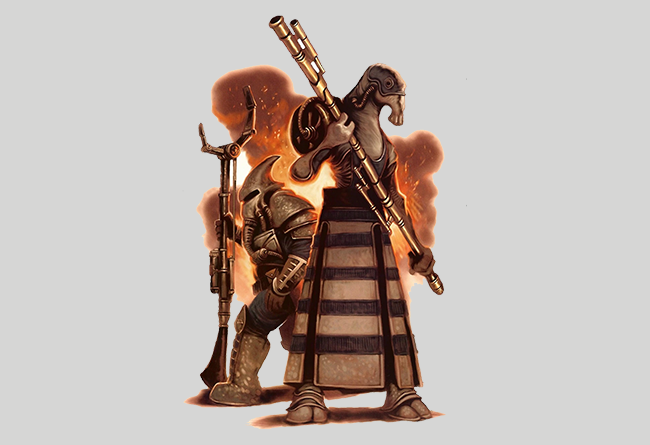Species: Mikkian
Home Planet: Mikkia
Attribute Dice: 12D
DEXTERITY 2D/4D
KNOWLEDGE 1D+2/3D+2
MECHANICAL 1D+2/3D+2
PERCEPTION 4D/5D
STRENGTH 2D/4D
TECHNICAL 1D/3D
Special Abilities:
Head Tendrils: Mikkian head-tendrils primarily served as sensory organs, particularly detecting sound as a replacement for an ear common in other species. However, some Mikkians, such as Zeen Mrala, possessed ears in addition to head-tendrils. Mikkian head-tendrils also could detect other information, such as humidity, temperature, magnetic direction, and radiation. This radiation detection was sensitive enough that Mikkians could “see” light and dark, although their eyes were still their primary visual organs. This gives them a bonus +2D to all search tests as they have senses beyond the norm, and allows them a +1D against being surprised as they can sense in all 360 degrees.
Story Factors:
Religious: Different religious traditions existed among the Mikkians, but belief in the Force played a central role in all of them. As such, when the Jedi Order were branded as traitors by the Galactic Empire, Mikkians were quick to question the Empire’s reasoning
Move: 10/12
Size: 1.6-2.0 meters tall
Background: Mikkians were a humanoid species that were native to the planet Mikkia, identifiable by their manes of head-tendrils and their bright skin pigmentation. The twin sisters Tiplar and Tiplee, who fought and died in the Clone Wars as Jedi Masters, were Mikkians. Another member of the species, a female named Sakas, fought with the Alliance to Restore the Republic in the Galactic Civil War.
The Mikkians’ most distinctive feature were their motile head-tendrils, the number, form, and pattern varying between individuals. These head-tendrils primarily served as sensory organs, particularly detecting sound as a replacement for an ear common in other species. However, some Mikkians, such as Zeen Mrala, possessed ears in addition to head-tendrils.
Mikkian head-tendrils also could detect other information, such as humidity, temperature, magnetic direction, and radiation. This radiation detection was sensitive enough that Mikkians could “see” light and dark, although their eyes were still their primary visual organs.
Mikkians’ skin ranged in pigmentation from bright yellows and greens to reds with blue highlights and pinks. Coloration varied greatly even among closely related individuals. For example, even twins, such as Tiplee and Tiplar, had vastly different skin pigmentations. Parents and children could also have very different colors.
Some members of the species were sensitive to the Force.





